Mon 10 Aug 2009
Archived Review: BRUCE ALEXANDER – Rules of Engagement.
Posted by Steve under Authors , Bibliographies, Lists & Checklists , Reviews[6] Comments
BRUCE ALEXANDER – Rules of Engagement.
Berkley, paperback; 1st printing, February 2006. Hardcover edition: G. P. Putnam’s Sons, March 2005.
This is the first of Bruce Alexander’s “Sir John Fielding” detective novels that I’ve read, and no, I didn’t realize it until after I’d picked it out to read that this is also the last one that Alexander ever wrote. And as perhaps you already knew, Bruce Alexander was the pen name of Bruce Cook, 1932-2003, who wrote eleven mysteries under that name. Under his own name, he had five earlier ones, four of them with Antonio “Chico” Cervantes as the leading character.
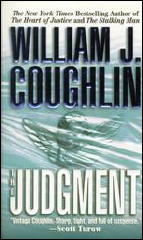
Now it gets interesting. (I’ll get back to Antonio “Chico” Cervantes in a minute.) Cook also was at least in part responsible for writing William J. Coughlin’s last book after he (Coughlin) died, The Judgment (St. Martin’s, 1997). I’m quoting from Al Hubin in Crime Fiction IV now: “Apparently written by Bruce Cook from a beginning by Coughlin, then finished and polished by widow Ruth Coughlin.”
The reason is that this is interesting, is that this is precisely how Rules of Engagement got written. From the back cover, and quoting again: “He (Bruce Cook) died in 2003, having completed most of Rules of Engagement, and left notes on how the rest of the story unfolded. John Shannon, author of the highly praised Jack Liffey series, most recently Dangerous Games, completed the novel with Bruce’s wife, Joan Alexander.”
As coincidences go, it would be rather minor, but was it a coincidence? Probably not. The idea was there, and the Bruce Cook and his wife simply carried it out in the same way it had been done before. And as you can easily imagine, there are both pluses and minuses in doing so.
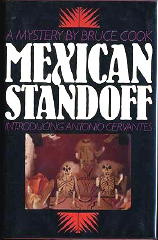
But before getting into that, and to Sir John Fielding and what the book (and the series) is about, I promised to tell you something about Chico Cervantes. This Thrilling Detective link will tell you more, but perhaps it suffices to say that Cervantes was a Mexican-American ex-LA cop turned private eye whose stomping grounds were (as you probably already guessed) Southern California.
His four recorded cases, published between 1988 and 1994, did not seem to turn the mystery fiction world on fire, and in fact, only one of the four, the first, Mexican Standoff, was ever published in paperback, the other three only in hardcover.
For whatever that tells you. In any case (no pun intended) the year the last Cervantes book came out, 1994, was the same year that Blind Justice, the first Sir John Fielding novel appeared. Cook, as Alexander, at the age of 62, had hit the equivalent of pay dirt.
I’ll append a complete list of the highly popular Fielding books at the end of this review. (I have them all. They are, unfortunately, still in the TBR (To Be Read) portion of the basement.)
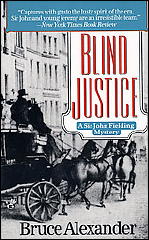
Sir John Fielding, as I hasten now to tell you (at last), was the blind English magistrate who was the real-life founder of London’s first true police force, the Bow Street Runners, in the mid-to-late 1700s.
What’s interesting about one of Alexander’s Fielding books, An Experiment in Treason, Benjamin Franklin makes an appearance. Unlike Robert Lee Hall’s series of books of the latter’s London adventures, though, in Treason Franklin is a suspect, not the detective, while in Hall’s books, Fielding is only a (relatively) minor character.
In the books by Bruce Alexander, Fielding’s household and close-knit circle of friends and close acquaintances takes center stage, filled to abundance with family, servants, many of which (if not most) are fictional. Especial note should be made of the narrator of the tales, one Jeremy Proctor, Fielding’s protege with him throughout the series, an orphan taken under his wing as a dogsbody, now in Rules of Engagement all of eighteen and Sir John’s clerk at the Bow Street Court.
The title comes in part from the fact that Jeremy is engaged to be married to Clarissa Roundtree, the other orphan taken in by the Fieldings: Clarissa as Lady Fielding’s general factotum, and as the book begins, he (Jeremy) is beginning to wonder greatly about his future. (On page 241 there is another context in which “rules of engagement” come into play.)
The mystery is extremely slight, but of course it needs to be mentioned. It concerns the strange death of Lord Lammermoor, who has recently jumped to his death from a bridge while crossing the Thames alone.
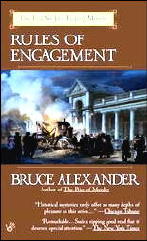
Several chapters later (or to be precise, in Chapter Three) the case is all but solved when Fielding and his entourage are entertained at the theater by a practitioner of “animal magnetism” and/or “mesmerism.” The only question that remains (to the reader, that is) is who is responsible, and while I cannot reveal his/her name, you will know as soon as he/she enters the story. (Ventriloquy is also an important factor, but my telling you that will neither enlighten you further, or less.)
One hopes for more, but more there is not, save 200 pages in which a great happens, but very little of any consequence. All in all, what the authors in combination have provided is nothing less than a worthy attempt to tie up some loose ends for the readers who followed the series and the characters from early on — but not all of them (the loose ends, that is). Life happens, and that is what is left for the reader to contemplate. This is one of the aforementioned pluses.
For someone expecting a detective story with some solid, down-to-earth detective work going on, either Mr. Alexander did not have one in mind, or if he did, neither his wife nor John Shannon were able to build one out of the notes that he left them. This is one of the aforementioned minuses.
For the record, the pluses outweigh the minuses, but personally, coming in at the end as I did, I left with a feeling of disappointment that I sincerely wished I hadn’t — come in at the end, that is.
If you’d like to call my verdict “mixed,” you’d certainly be right. I wouldn’t deny it at all.
The Sir John Fielding novels by Bruce Alexander:
All were published in hardcover by Putnam and in paperback by Berkley. The dates are of the hardcover editions; the paperback generally appeared a year later.
Murder in Grub Street. 1995.
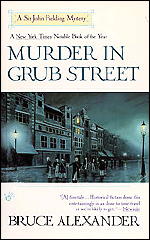
Watery Grave. 1996.
Person or Persons Unknown. 1997.
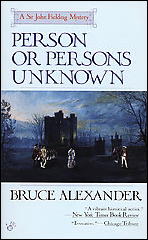
Jack, Knave and Fool. 1998.
Death of a Colonial. 1999.
The Color of Death. 2000.
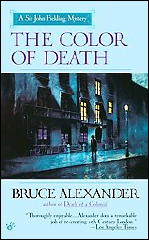
Smuggler’s Moon. 2001.
An Experiment in Treason. 2002.
The Price of Murder. 2003.
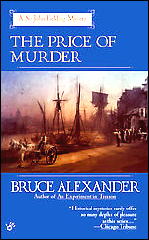
Rules of Engagement. 2005.
August 11th, 2009 at 9:41 pm
Generally I like books dealing with the Bow Street Runners, but for some reason I found these a bit dry. It’s possible that was just in comparison to more lively writers like Jeffrey Farnol, Raymond Foxall, Richard Falkirk (Derek Lambert), or J.G. Jeffries. Fielding is an interesting character, but here I just found him a bit dry for my taste in this historical era.
Also, as I remember this one there is a common mistake about ventriloquism in it, though I may be confusing it with another book.
August 11th, 2009 at 10:01 pm
This is the only one of the series that I’ve read, so as I was reading through the review again today, I could sense that I was trying to avoid taking the flaws of RULES and generalizing them to all of Cook’s Fielding books.
But “dry” is an appropriate word, I believe. I noticed it, too, but I attributed it to the desire on the part of Cook’s collaborators on the book, John Shannon and Cook’s wife Joan, to tidy up the personal stuff at the expense of the mystery.
Even so, I’d like to read more in the series, but given your similar reaction, all things considered, it’s more than likely that I won’t.
And since I mentioned ventriloquy in my comments, I’m sure that this is one you’re remembering. At this late date, I don’t recall if I was hinting at a mistake that was made or not, but I probably was.
— Steve
August 11th, 2009 at 10:33 pm
The most common mistake regarding ventriloquism is having the ventriloquist fool someone by throwing his voice behind their back. Since ventriloquism is an illusion and the voice isn’t actually “thrown” anyone who hears a ventriloquist from behind hears the voice coming from the source. Even Agatha Christie made a mistake with how it actually works. You have to be looking at the ventriloquist for the illusion to work.
August 11th, 2009 at 11:33 pm
Yep, I learned that the hard way, back in the mid-fifties (junior high). Thanks to a convincing ad in a comic book, I bought a book on throwing my voice from a Johnson Smith catalog.
Was I disappointed!
I did buy a lot of other neat stuff from them, though.
But in terms of the book in question, I don’t know if this was the error or not — or if it was something else altogether.
— Steve
August 12th, 2009 at 9:52 pm
The x-ray glasses didn’t work either, and the sea people were a bit lame, but I got my dollars worth out of those little hard rubber soldiers — especially around the 4th of July when we could afford to blow them up and replace them. We assembled a fair size army of WWII, Roman, and Civil War sets in my neighborhood and conducted some hard fought campaigns.
I never did try the ventriloquist act, but did have the Howdy Doody and Jerry Mahoney puppet and dummy.
Re Alexander I mostly recall the ones I read being fairly dry and colorless — certainly compared to the other writers who used the Bow Street Runner setting. You would think the half brother of Henry Fielding who wrote Tom Jones and Jonathan Wild would be a bit more colorful.
Below is a list of Fielding’s appearances elsewhere from Wikipedia (so how accurate it is I leave up to the reader), there is also a good portrait of Fielding at their site:
A fictionalized Sir John Fielding is the protagonist of eleven historical detective novels (set in Britain’s Georgian period), written by the American writer Bruce Cook, under the pseudonym Bruce Alexander.
John Fielding is an important character of the historical detective novel Death in the Dark Walk (1994), written by Deryn Lake.
John Fielding is portrayed by David Warner in the 2006 British television film of Sweeney Todd, starring Ray Winstone.
The 2008 Channel 4 television series City of Vice is based on the crime investigative work of the Fielding brothers. Iain Glen plays John Fielding.
John Fielding is a recurring supporting character in a series of Benjamin Franklin mysteries by Robert Lee Hall — set in London during the late 1750s. In many instances Fielding himself requests Franklin’s help solving a murder.
Charles Dickens used John Fielding as a character in his Barnaby Rudge.
Just as a historical note I don’t think John founded the Bow Street Runners until after Henry’s death. It’s been a while since I read them, but Fielding is certainly mentioned and even appears in many of the other Bow Street Runner series by other writers, though I can’t recall if he is mentioned in Richardson, Recollections of a Bow Street Runner which Dickens ghost wrote or at least edited.
June 18th, 2011 at 11:14 pm
The other book in the series were much better and had more interesting detective work. Having read all the books (mostly in order), it was kind of nice to have the loose ends for the characters tied up, but the plot of this one was rather strange and had various aspects that weren’t very believable. Don’t judge the rest of the series by the last book. The earlier ones were much better.